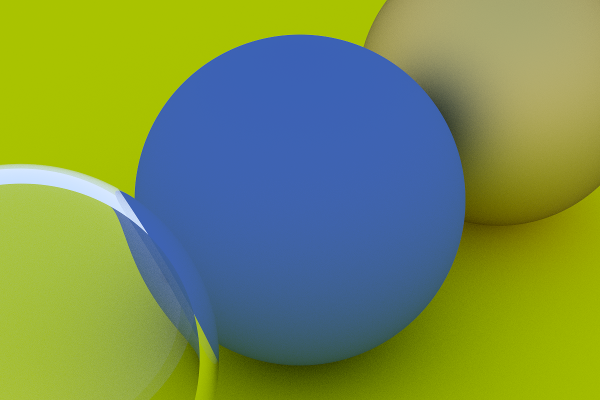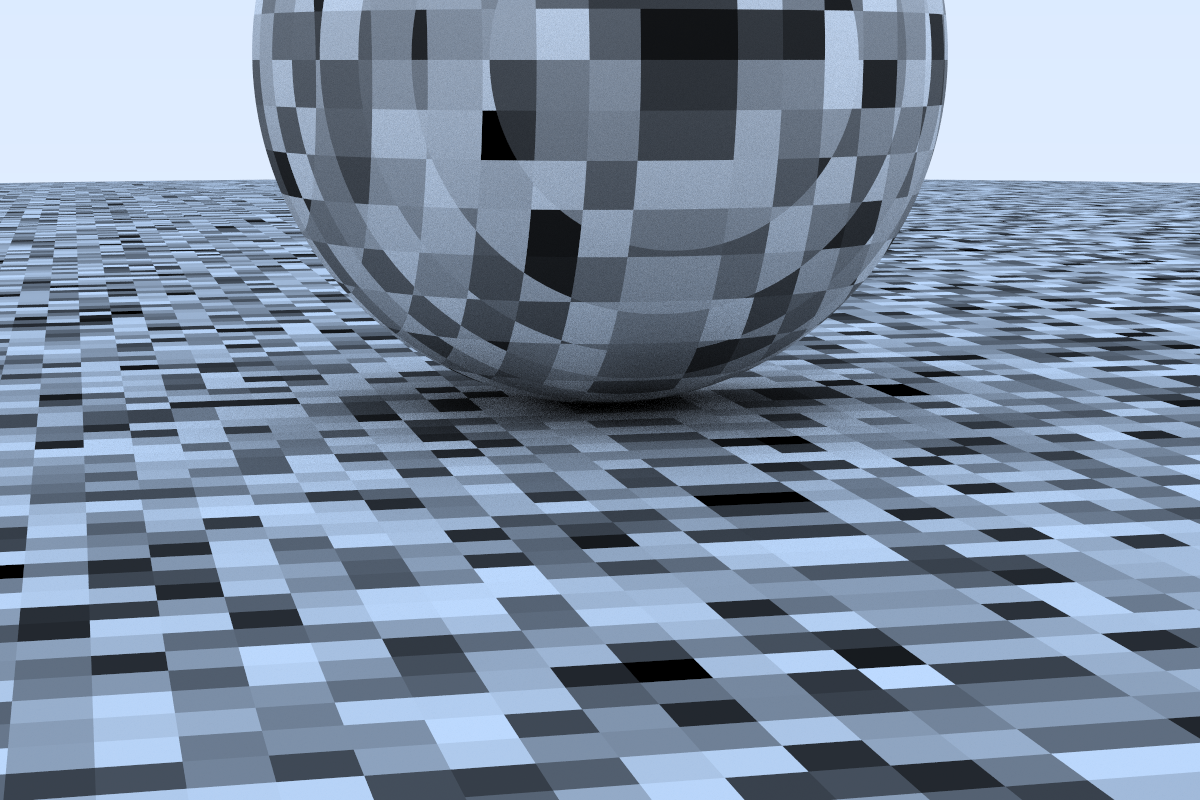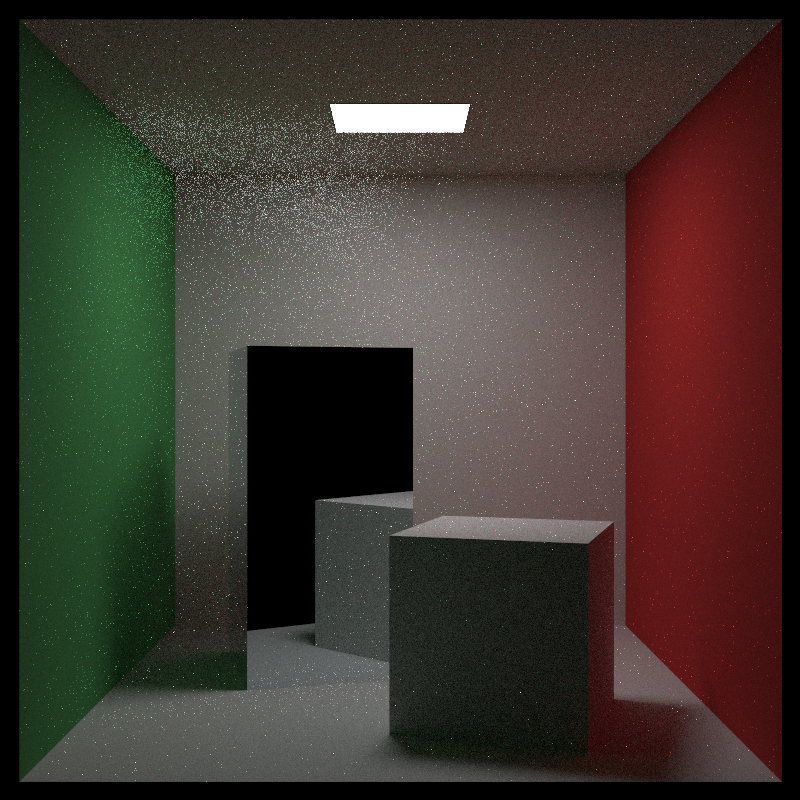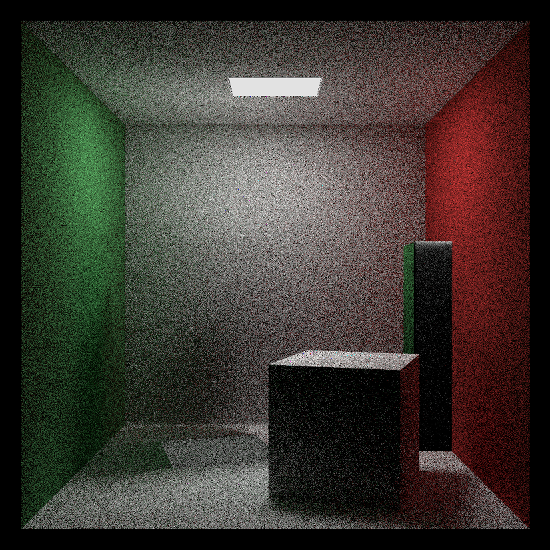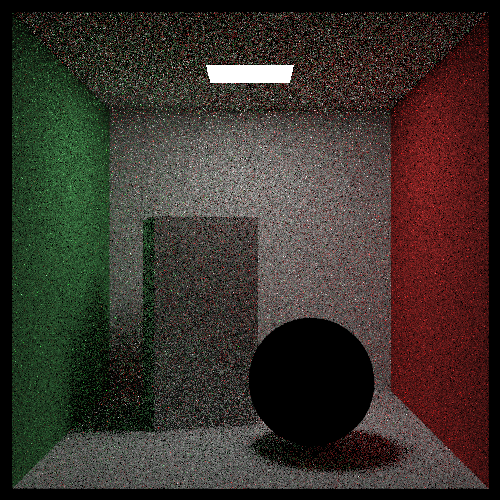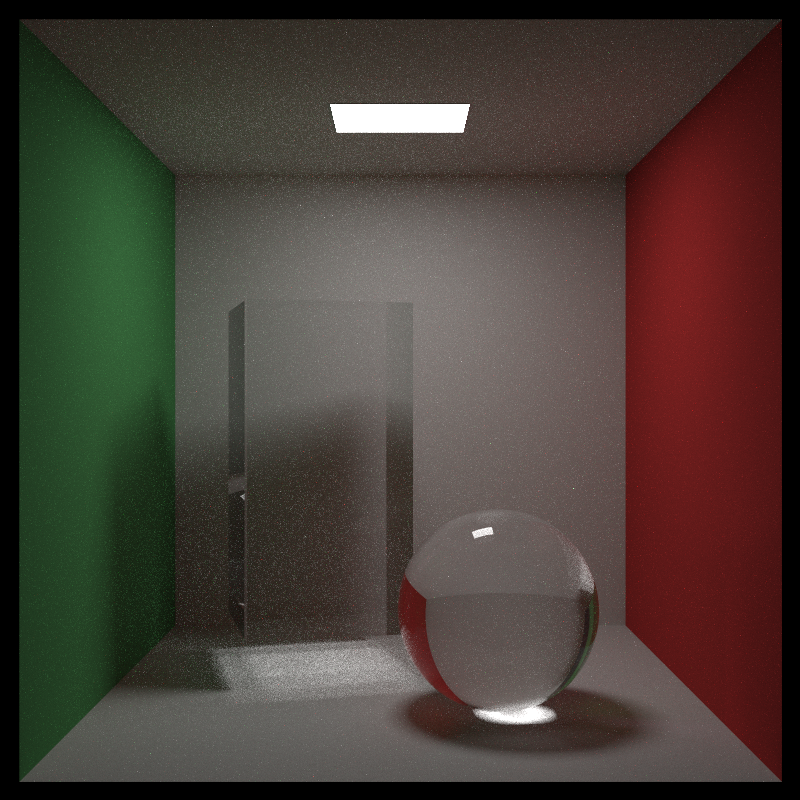This is going to be a little different than only a usual book review; in fact, it's going to be a review of three books (that were part of a series). They are Peter Shirley's Ray Tracing mini-books. If you've been following my blog for the past few entires you may of noticed that I've been on a bit of a Nim binge lately. I've only been at it for about two months. So in an effort to learn the language better and to go through the books at the same time, I decided to write the book's code in Nim instead of the original C++. It turned out to be smoother than expected (though with some troubles along the way).
What is Nim?
I first heard about this language from the /r/programming subreddit. Every few weeks or so I'd see a link entitled "Nim v0.x.x released," or something like that. I didn't take a look into it until I saw a few of those and said to myself, "Alright, I think it's time to actually take a look at it." Since then, I've been doing most of my free time stuff in Nim.
The best tl;dr I can make to describe Nim would be "It's a python-ish language that compiles down to C/C++." There's definitely a lot more to Nim than just that. Reading from the project site is what really piqued my interests other than the native backend and syntax. There are features that give you a lot of control over the language. For example, you can use constructs such as macros and templates to define your own extensions to the language. One of it's most powerful aspects is how easy it can talk to C/C++ because well, Nim turns into that at the end of the day. Nim is able to take advantage of most of the existing C/C++ libraries with minimal effort. There already exist bindings for things like OpenGL and libSDL. There's even a framework to do web programming too.
I've seen a fair bit of comparisons with Mozilla's Rust and Google's Go, but I don't want to talk about that. The community is not crazy active like many other languages; it's more cozy if anything. Keep in mind that Nim is still very young, yet it's highly impressive what they've been able to do without any massive corporate backing. Yet.
Finding a Ray Tracing Book
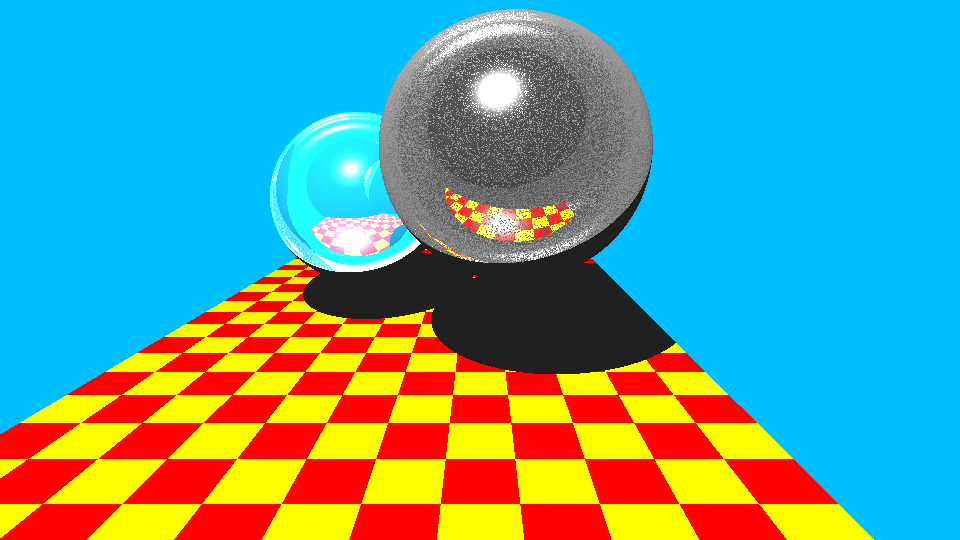
It didn't turn out so well for me.
In my last semester of university I took a grad level course in Global Illumination. With the Ray Tracer that I made, I wasn't too happy with the final results. I wanted to give it a second shot. So I headed to Amazon to look for a book. Yes, yes... I know there is a lot of good information out there already free on the Internet, but for some reason I just seem to learn better from reading in a book format. Anyways...
I saw a book called "Ray Tracing in one Weekend," at the top of the search. It caught my eye because:
- It was short
- It was inexpensive, three bucks (that's less than a cup of coffee)
- The code was in C++, and OS independant
- It mad the promise of building a functional Ray Tracer
- It came in a three part series. If I didin't like the first one, I could always ditch the second two books to find something else
I was sold.
Book 1 - Ray Tracing in One Weekend
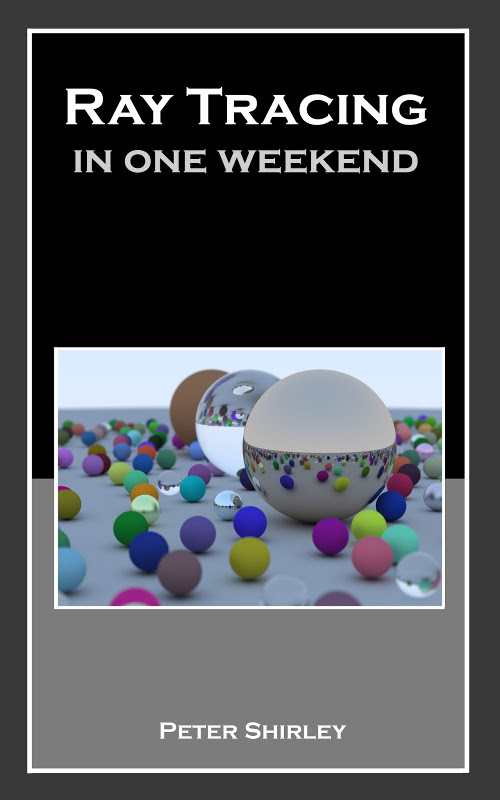 At the beginning of the book you will first have to set up your rendering infrastructure. All of the code makes no use of external libraries (except for one in the second book). That means having to build a 3D vector class, Rays, and other geometric goodies. Nim does come with it's own built-in 3D vector object, but I decided to forego using it so I could get the "full experience."
At the beginning of the book you will first have to set up your rendering infrastructure. All of the code makes no use of external libraries (except for one in the second book). That means having to build a 3D vector class, Rays, and other geometric goodies. Nim does come with it's own built-in 3D vector object, but I decided to forego using it so I could get the "full experience."
Now you might be saying "So how did you save renders then?" PPM. On standard out. Yeah, it's not my favourite image format either, but it got the job done and it is probably the simplest format to export without any extra libraries. And if you have a tool like ImageMagick converting it to something that people actually care about (e.g. PNG,) is trivial.
What's really nice about this book is how the author goes through step by step with you to build each component one at a time. I've had one too many tech books that I've slapped down $50 (or more) to only give me half-assed partial snippets and no walkthrough. Peter Shirley did a very good job of avoiding that. The code in this book had very few errors to none at all; a very great thing. With the amount of code in the book, I'd say you should be able to go through it in about three to six hours time.
I really wish I read this book before taking my course in Global Illumination. It would have made my life much easier and saved me a load of time and frustration.
Book 2 - Ray Tracing: the Next Week
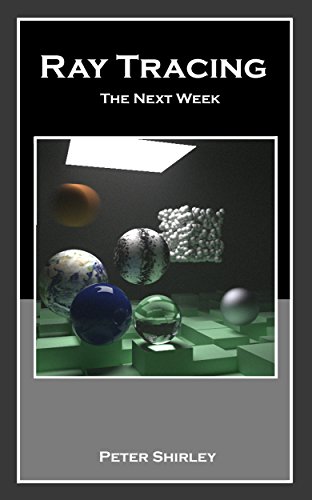 This is the book in the series that I learned the most from, but it is also the one that cost me the most agony and time.
This is the book in the series that I learned the most from, but it is also the one that cost me the most agony and time.
A lot of that could contribute to the fact that I was porting the code to a language that I was new to, but this book did have it's share of errors and missteps. For example, there were a few times where Shirley forgot to mention to make a change to something; one of the things that drives me up the wall when reading a tech book. Despite all of this I was able to get through the book, but it took way more than a week (the titled lied to me,) and I had to manually trace things through in the original C++ repo more than I should have.
Annoyances aside, this book goes over things like texture mapping (on spheres only), perlin noise, interpolation, BVH trees, and other stuff. What's more exciting is that actual emissive lights get introduced. In the first book there wasn't really any lighting, it was all ambient and sun-like. Now, we had real lamps. There are also a lot more scenes constructed in this book than the last. Including that famous Cornell Box. There is an external library introduced, but luckily it's stb_image.h; one of those magical single header file libraries. Binding it to Nim was a sinch.
I'd only recommend reading this book if you really are interested in Ray Tracing beyond what was presented in the first.
Book 3 - Ray Tracing: The Rest Of Your Life
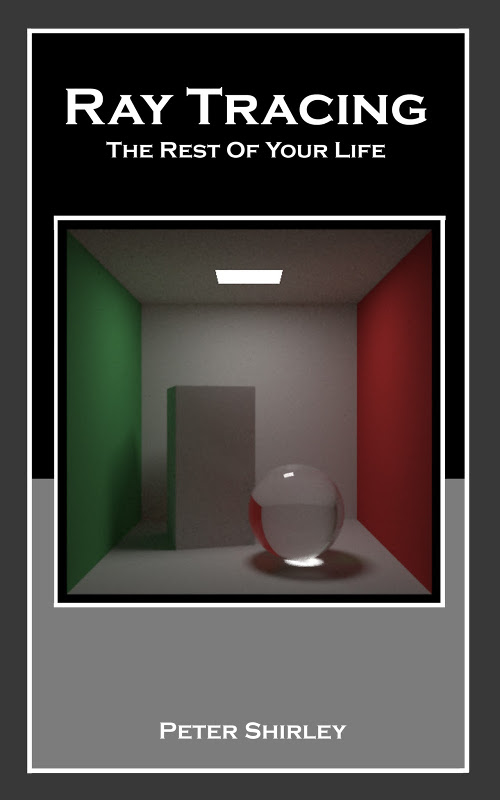 This one ended up being a lot more math and theory based, as you refactor the Ray Tracer into a Monte Carlo one. And... that's really much it. Every single scene that is rendered is based around the Cornell Box. It would have been nice to have a little more diversity rather than replacing a box with a glass sphere or making one a mirror-like surface, but it doesn't take away from what's talked about.
This one ended up being a lot more math and theory based, as you refactor the Ray Tracer into a Monte Carlo one. And... that's really much it. Every single scene that is rendered is based around the Cornell Box. It would have been nice to have a little more diversity rather than replacing a box with a glass sphere or making one a mirror-like surface, but it doesn't take away from what's talked about.
What's really nice about this one is that it was a much quicker read for me than the second, less frustrating, the images rendered way faster, and ended up looking much better to boot. There was only one problem; in the final chapter the author did that thing again where he forgot to tell you to update something. I don't think it would have been so bad if I did the thing in C++ instead of Nim. I'll get to why later...
All in all, I would actually recommend this one over the second just a little bit more. Some of the things in it could fly over your head, but there were next to no errors in the book (just one).
Book Series As A Whole
As I said before, I wish I had a copy of the first book before going into my course where I had to build a Ray Tracer. It covers many of the necessary basics plus some extra fun things.
All of the issues that I bumped into in the second one were quite jarring. I've sent a laundry list of them to Peter Shirley. He's been very responsive to all of my emails and has fixed issues with his books in the past. Expecting him to clean them up during the Thanksgiving-Christmas-Hanukkah-Kwanzaa-Festivus-New Years blitz (a.k.a. November & December) is not a fair demand, but he should eventually. Once these get fixed up I think it will be a much stronger series.
Except for the errors, the source was of a good quality. It was mostly clean, readable, and simple. The only thing that I didn't like was the organization of the code. I know you get what you pay for ($3) but it wasn't really that well structured. It made the software engineer in me hurt a little. The code was also provided as one big lump in a GitHub repo. Other tech books I've read have been nice enough to divide up the progress from each chapter in their own separate folder. This would have been good to do instead.
I'm a little saddened this didn't go over other things like the BRDF or a bit of ray marching. It would have been better to have more in the third book than only a Monte Carlo renderer. I also don't think the title of the last book is really accurate if you choose to do more Ray Tracing after reading it. This book series should not be treated as a replacement for a university course; I learned a lot more about ray tracing and computer graphics at school.
With these negatives, I think the positives out way them and make the series worth the money to pay for it.
What it was like doing this in Nim
There always seems to be a relevant XKCD for every situation. In the realm of compiled languages Nim really made me feel like I was flying again.
As I said before, I did this book in Nim as an excuse to learn the language better. I've made a few toys with Nim prior, but I felt working on a larger (iterative) project would force me better understand the language. At the end, I did learn a lot more..
Translating between C++ and Nim wasn't that difficult at all. The book's source wasn't complexly constructed in areas of OOP, and Nim's OOP functionality is still fairly basic, so there was almost a one to one correspondence with what I would have to write. When there was a C++ class, I would typically turn that into a type CLASS_NAME = ref object of RootObj. It would hit most of my needs but one time it came back to bite me in the butt. Looking up witch Nim proc to use in place was something a pain, as Nim's documentation isn't the best at the moment.
Things always felt very fluid and fun for me. It felt a lot like I was writing Python code that was type checked. The operator overloading is also some the easiest I've seen in any language. And because of having to use stb_image.h I got a taste of how to work with the foreign function interface. Heck, I even ended up doing a proper wrapper of the library.
So how that ref object of RootObj got me... I would translate all of the C++ classes using this. That would create reference counted pointer to an custom object I defined. Upon object creation, which would be stored in dynamic memory. When I was first working on the Cornell Box I got this:
Yeah, that's pretty bizarre. That back box is off to the right (through the wall), yet it's shadow and diffuse reflections are on the room walls and floor. After pulling my hair out form running through the code I finally figured out that ref object of RootObj was what perpetrated it (or how I used it), along with this snippet:
method hit*(ry: rotate_y, r: ray, t_min, t_max: float, rec: var hit_record): bool=
# I thought this was copying the vec3 data, but it wasn't. It was copying the pointer...
var
origin = r.origin()
direction = r.direction()
# origin and direction are modified after this which caused the issue...
I wasn't creating a copy of the 3D vector, I was modifying the original vector… After that I changed that vector class over to a simple object.
Another problem I had with Nim is that it doesn't yell at me as much as C++ does. When I was working on the last book, my renders were coming out like this:
"How the heck is that glass sphere turning into a black hole?" went through my mind. This also made me spend too much time chasing the errors down in the wrong places. Partially, this issue stemmed from Peter Shirley not reminding me in that last chapter to update the dielectric::scatter() method. But when I changed the prototype for the base method material::scatter(), Nim didn't yell at me to fix the child methods too. It just used the base method instead, which would return black. When you change a base method's prototype in C++ the compiler will remind you to change all the children too. For once, I wish I was being screamed at.
There is also some other odd behavior I want to look further into too. In the second book we built a BVH Tree hierarchy to store the scene info, as to make the ray collisions much faster than checking each object one by one. Storing the hittable objects in a sequential list was faster than searching the BVH Tree. It could be my implementation of a bounding volume hierarchy, but I'm sure it's functionally correct.
As for the performance of the Ray Tracer. It's not as fast as the C++ one it was ported from, though it is still pretty good. If I were to have written this in Python (what Nim resembles), I think the images would still be rendering well into my 80s. The port that I have is definitely not the most riced thing possible. There's probably a ton of other optimizations that can be made. But here are some comparisons:

Commit was: "fd77499840b4a93441b4c9d772258da85fecc265". Resolution was 1280x800. "ns," stands for number of Rays/Samples per pixel. All were done on a Desktop Intel i5 machine, single core w/ no threading. The Linux "time," utility was used to benchmark. I think the performance slowdown with book 2's Nim implementation has something to do with the BVH node. I'll be investigating it and hopefully fixing it.
Nim is still very young so I don't think it's fair to be overly critical, and I'm also very new to the language myself. I will continue to do more things in Nim as I really like it.
If you want to learn more about Nim here is the website and here is a good place to start. You can find the Nim Ray Tracer here (GitHub mirror). And if you're interested in the books, here are their Amazon pages:

